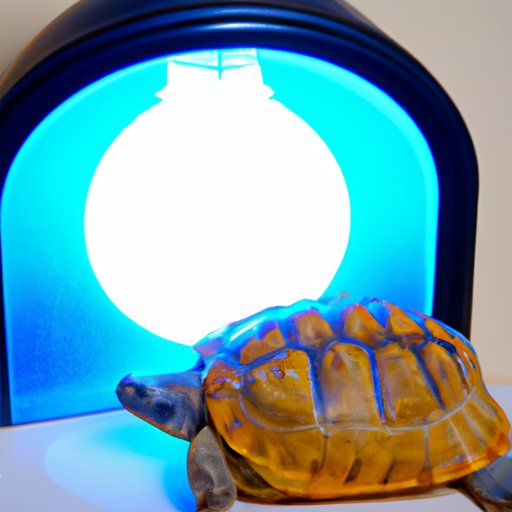Introduction
Turtles are unique animals that have been kept as pets for centuries. While they can make wonderful companions, it is important to understand their needs in order to keep them happy and healthy. One of the most important considerations is whether or not a turtle needs a heat lamp to maintain its optimal health. This article will explore this question in depth by comparing the natural environment of wild turtles to captive turtles, examining the role of temperature in a turtle’s health, and understanding the impact of artificial light sources on turtles.

Comparing the Natural Environment of Wild Turtles to Captive Turtles
The first step in determining whether or not a turtle needs a heat lamp is to compare the natural environment of wild turtles to captive turtles. In the wild, turtles live in a variety of habitats, including ponds, streams, marshes, lakes, rivers, and wetlands. These environments provide turtles with plenty of food, shelter, and space to roam. The temperature in these areas can vary significantly depending on the time of year, but generally stays between 70-90°F (21-32°C).
Domestic turtles, on the other hand, are typically kept in enclosures that are much smaller than their natural habitats. These enclosures often lack adequate heating and cooling systems, meaning that the temperature inside can fluctuate drastically. Without proper temperature regulation, turtles can become stressed and unhealthy. This is where a heat lamp can be beneficial.
Exploring the Necessity of Heat Lamps for Domesticated Turtles
Heat lamps are an essential tool for keeping domestic turtles healthy and comfortable. Turtles need a certain range of temperatures to stay healthy, and heat lamps help to regulate the temperature in the enclosure. Generally, turtles should be kept between 75-85°F (24-29°C). If the temperature drops below 75°F (24°C), turtles can become lethargic and weak. If the temperature rises above 85°F (29°C), turtles can become overheated and stressed.
In addition to providing warmth, heat lamps also help to provide a day/night cycle for turtles. This helps to keep their circadian rhythms in check and allows them to rest properly. Heat lamps also provide a source of light, which is important for turtles to feel safe and secure in their enclosure.

Examining the Benefits and Drawbacks of Using a Heat Lamp for a Turtle
Using a heat lamp for a turtle can provide many benefits, but there are also some potential drawbacks. On the plus side, heat lamps can help to maintain the ideal temperature for a turtle, allowing it to stay healthy and active. Heat lamps can also provide a source of light, which can make turtles feel more secure in their enclosure. Finally, heat lamps can help to create a day/night cycle for turtles, allowing them to rest properly.
On the other hand, there are some potential risks associated with using a heat lamp for a turtle. Heat lamps can create hot spots in the enclosure, which can be dangerous for turtles if they get too close. They can also create fluctuations in temperature, which can be stressful for turtles. Finally, heat lamps can attract insects, which can be a nuisance.
Investigating the Role of Temperature in a Turtle’s Health and Well-being
Temperature plays an important role in a turtle’s health and well-being. Turtles rely on thermoregulation, which is the process of controlling their body temperature. When their environment is too cold, turtles will bask in the sun or near a heat source to warm up. When their environment is too hot, turtles will seek out shade or water to cool down.
If a turtle’s environment is too cold or too hot, it can lead to health issues. Cold temperatures can cause a turtle to become lethargic, while hot temperatures can cause dehydration and stress. It is important to ensure that the temperature in a turtle’s enclosure is kept within the optimal range of 75-85°F (24-29°C) in order to prevent these issues.

Understanding the Impact of Artificial Light Sources on Turtles
It is important to note that not all light sources are created equal when it comes to turtles. Natural light from the sun is the best option for turtles, as it provides the full spectrum of light that turtles need for good health. Artificial light sources, such as heat lamps, can be beneficial in some cases, but they can also be dangerous if used incorrectly.
Artificial light sources, such as fluorescent bulbs and LED lights, emit UV radiation that can be harmful to turtles. Too much exposure to UV radiation can cause eye damage, skin cancer, and other health issues. It is important to use the correct type of light bulb for the turtle’s enclosure, and to make sure that the bulb is not too close to the turtle.
Conclusion
In conclusion, heat lamps can be beneficial for turtles, but they should be used with caution. Heat lamps can help to regulate the temperature in a turtle’s enclosure, providing a comfortable environment for the turtle to thrive. However, heat lamps can also create hot spots and fluctuations in temperature, which can be dangerous for turtles. It is also important to be aware of the possible risks associated with using artificial light sources, such as UV radiation.
Overall, heat lamps can be a useful tool for keeping turtles healthy and comfortable. However, it is important to monitor the temperature in the enclosure closely and to use the appropriate type of light bulb to avoid any potential health risks. With the proper care and attention, turtles can enjoy a long and happy life.


